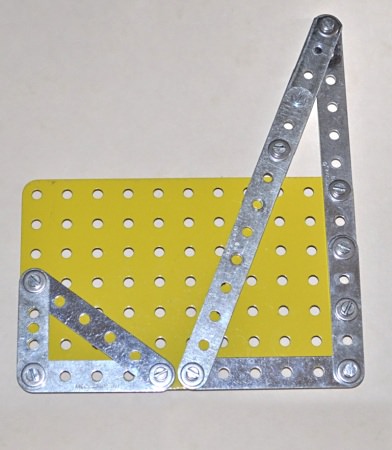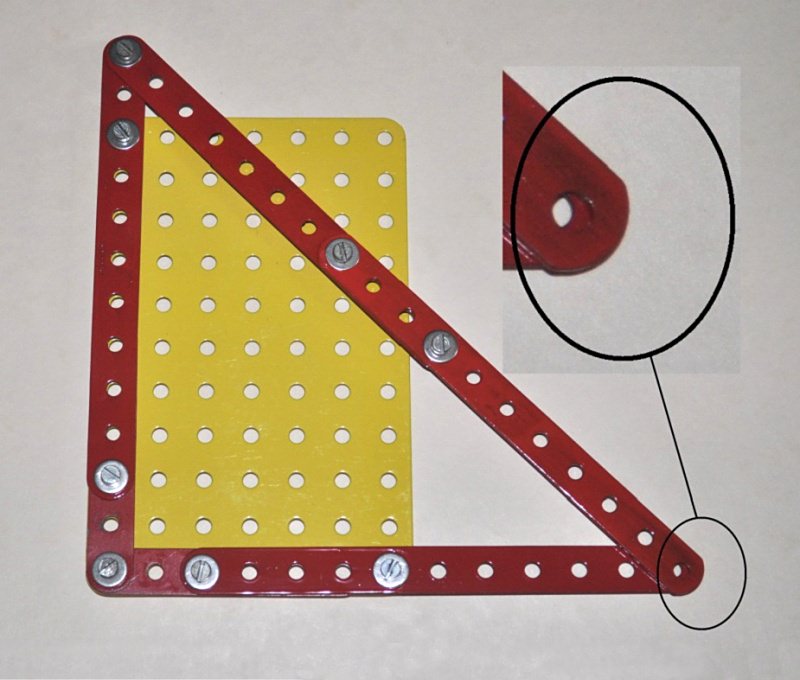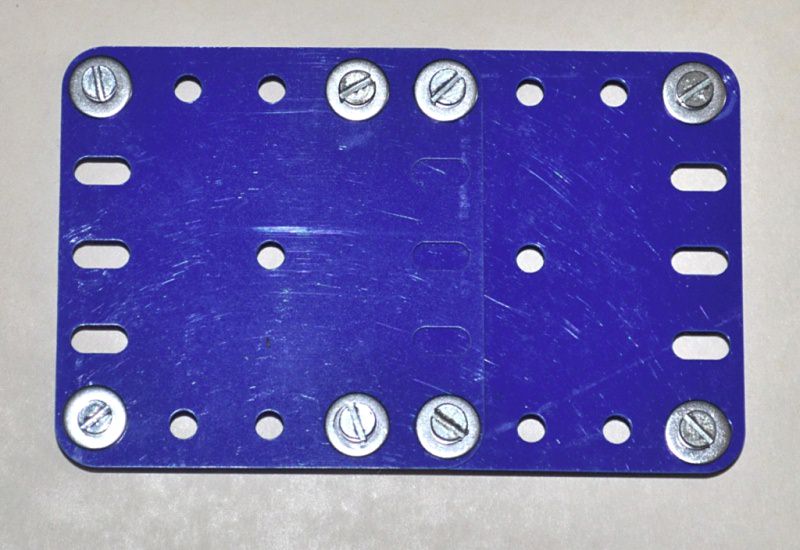Summer 2016 Newsletter

Summer 2016 Newsletter
Issue 159
This was one of our informal quarterly meetings where our members showed off their latest Meccano creations.
At around 2:00pm we had a short committee meeting, followed by the Model Tour in which members were invited to give a short talk about their models — in particular their entries for the Secretary’s Challenge!
Report written by Tim Surtell
On 2nd April Chris Warrell, Brian Leach and I took part in SELMEC’s second outing to the Royal Institute of British Architects (RIBA).
At last year’s ‘Day of Play’ we had the use of three six-foot tables in the Aston Webb Room upstairs and it got a little cramped, with some families having to sit on the floor. This time Meccano got promoted, becoming the main attraction in the Florence Hall (move over Lego!) with eight large round tables each seating eight.

Families building bridges in the Florence Hall
Once again, Meccano generously supplied us with several new sets, and families were soon busily building away as we gave guidance.
With the event being titled ‘Total Wipeout!’ to coincide with RIBA’s ‘Creation from Catastrophe’ exhibition, we decided to run a Meccano Bridge Building Challenge in which families would compete against each other to see who could build the strongest bridge.
The footprint of each bridge had to be at least 14½ x 1½ inches, and be flat enough that it could be placed correctly on the test rig.

Checking the size of parts against the template
A testing machine was placed underneath each bridge and its feet adjusted so that there was a slight gap between bridge and machine. The bridge was then loaded up with nuts and bolts until it flexed enough to activate one of the four tactile buttons inside the machine, lighting an LED and sounding a buzzer.

The testing machine

The whole testing setup
After the nuts and bolts were weighed, and the weight of the bridge was taken into account, each bridge was given a score. The scores were recorded on a laptop computer so that an up-to-date leaderboard could be displayed.

Chris testing out a bridge
The winner was Matthew Brook, who went home with a new Tower Bridge set (what else?) as his prize. His bridge, weighing only 210g, withstood almost 5kg before flexing.

The winner, Matthew Brook (left), with his bridge
How did you do in the Bridge Building Challenge? You can see the scoring leaderboard along with all the Bridge Building Challenge photos in our Facebook album.
A few times during the day Godzilla made an appearance, entertaining everyone by ‘destroying’ a bridge! In fact Brian (Godzilla) had brought along his own special bendable bridge for this express purpose.

Godzilla entertains by wrecking a bridge!
You can see more photos from the Family Fun Day in our Facebook album.
Report written by Peter Clay
Five SELMEC members exhibited on stage at the annual Hornby Trains Exhibition in the Methodist Church Hall, Welling on 30th April.
Starting with the models, in alphabetical order:
Adrian Ashford (rather busy in the main hall!) had an articulated electric truck and an owl, whose wings flapped when a button was pressed.

Adrian Ashford (foregound) with his Hornby train layout
Peter Clay had a new Meccanograph (a ‘variable linegraph’). Unfortunately the motor drive gave problems and it had to be hand-cranked. His fears of RSI proved unfounded! Also seen were a tractor (with flywheel drive) and trailer in the new grey and silver finish, Dad’s Army butchers’ wagon, four-wheel steering car and Chinese Chariot. This had three pointers, one above, one below and one working when the operating rod faced upright. Each pointer then kept its orientation when on top.

Peter Clay’s variable linegraph
Brian Elvidge brought three attractive models: A lorry based on a Guy Vixen Dinky model — this used the cab and chassis of the red/green № 7 set refuse wagon and was powered by a № 1 clockwork motor; a solidly built aircraft from a recent 2015 set, one of the extra models available on line; and finally, an excavator based on the Evolution set of 2013, with the addition of a tracked base. It had slewing, digging and luffing movements.

Brian Elvidge’s excavator
Brian Leach had an appealing duck and an auto-belt tensioner. This was a belt drive whose pulley climbed around a gear, so that the belt tension was automatically adjusted as the load increased. It was driven by an electric motor. Details have been given in the literature but it is always fascinating to see it in operation.

Brian Leach’s duck
Tim Surtell showed us what can be done with electronics and computer control (or, if you’re like me, blinded us with science!) He demonstrated a robot arm controlled from a laptop. Its unfortunate floppiness was due to limitation in the new polycarbonate parts making it difficult to brace. This, plus demonstrations of stepper motors and of control of Meccano motors, was worked through an Arduino Uno microcontroller. Not to be outdone, Tim had more traditional fare — a maraca, ice cream cart and walking 'Meccanoide' which walked forwards or backwards when the buttons were pressed.

Tim Surtell demonstrating his robot arm
Flyers for the SELMEC Meccano Show were on offer and many were taken up.
An exhibition is more than the sum of its models. There was also the real purpose — the model railways and items for sale. Adrian told me that there had been a good number of visitors and was pleased with the day overall — which was a tribute, of course, to himself.
Our Meccano display was enjoyed by young and old alike. Among the visitors were Chris Warrell, George Foard, John Cowdery and, from Holy Trinity Meccano Club, James Dowswell. Apologies if I’ve missed anybody.
You can see more photos from the show in our Facebook album.
Report written by Adrian Ashford
Watch our video of the show
This year’s show at Kew was held on 23rd and 24th April at what is now called the Museum of Water and Steam, since its reopening last year.
This was, in fact, the second Meccano show since the museum’s refurbishment, and was, as in the past, well populated with Meccano modellers and their models from various clubs — pretty well all the usual suspects in fact! I didn’t make a note of individuals and their models, but there was the usual very diverse range, covering an equally diverse range of subjects.

Looking over the main hall
SELMEC was, as usual, well represented; it was good to see our former Chairman, Frank Paine, with his wonderful display of Meccano sets and other ephemera.

Colin Bull’s model of the Laxey Wheel

Frank Paine’s Meccano display
It is a pity the whole of the basement area is no longer available for model displays, though the use of the former refreshment area offsets this to some extent. I went as a visitor on the Saturday and the show seemed well attended by the general public.

Plastic Meccano dragline by Matt Goodman
Thanks are due to Jim MacCulloch for organising the event once again, although he was unable to be there over the weekend. In addition to the Meccano models, visitors were able to savour the sights and sounds of the various engines being steamed at different times. It’s wonderful to see the massive engines actually working — they certainly provide plenty of inspiration for Meccano models!

Forestry tractor by Willy Dewulf
[Editor’s note: Jim reported that the attendance was 476 over the whole weekend, which the museum was very happy with.]
Report written by Chris Warrell
Friday 19th to Sunday 21st February saw the Modelworld show in the Brighton Centre right on the seafront. It covers almost everything, from model railways, radio controlled trucks, circus and fairground, plastic kits, boats, model engineering, Lego and, of course, Meccano. There were also clubs and preservation groups represented. You need a few hours there to do it justice.

Some trams on show at Modelworld
There were four stands displaying Meccano: Michael Molden with a ghost train, Andy Ripley with a freelance double Ferris wheel, along with our own Guy Loveridge and his Volk’s Railway and a bus, and Les Chatfield with a large number of models including a tower crane, scooter, railway, Meccanograph etc.

Michael Molden’s ghost train

Andy Ripley’s Ferris wheel

Guy Loveridge’s Volk’s railway and bus

Les Chatfield shows off his models
Written by Richard Marsden
You’re standing behind your models at the exhibition, discussing the educational aspects of Meccano with some parents. Suddenly their offspring start tugging furiously at their sleeves, anxious to be somewhere else, or indeed, anywhere else. It’s not a school day, and you’ve just used the ‘M’ word. No, not ‘Meccano’, or even ‘money’, but ‘mathematics’. But there is mathematics in Meccano, and the more you look, the more you’ll find. Some children will eventually thrive on this; many don’t. These parents hope theirs will; that’s why they came to the exhibition.
For a start, every Meccano boy and girl might well know his or her nineteen-times table, even if a little hazy about four-times-nineteen and six-times-nineteen.
If they’ve been given more Meccano gear wheels and pinions they can make up ratios of 4:1, 3:1, 2:1 and 1:1. An astute purchase from the inestimable Mr. Taylor will add a first ratio of 5:1. While this is about the right total range for a car gearbox, a car with these ratios would be very awkward to drive, because of the huge gap between 4th and top, especially compared to the much smaller gap between 1st and 2nd. “Why?”, the young constructor might ask. After all, the numbers go up in a steady sequence, 1, 2, 3, 4, 5. An arithmetic series, in fact. No, with regard to the car’s road speed, the series is really 0.2, 0.25, 0.33, 0.5 and 1.0, and that’s a harmonic series, an arithmetic one ‘upside down’. Writing it this way shows the increasing gaps between the gears. What works better is a geometric series, so that changing to the next gear gives the same percentage change in engine speed, regardless of which gear you are moving to.
A typical geometric series might be 0.0625, 0.125, 0.25, 0.5, 1.0, where each number is twice the previous one. In the car gearbox example, the multiplication factor might be 1.5, giving the series approximately 0.2, 0.3, 0.44, 0.67, 1.0. In a real car, for other reasons, the ratios will be spread further in the lower gears and closed up in the higher ones, and top gear does not need to be 1:1, but the point has been made. Three mathematical number series for the price of, well, ten Meccano gear wheels.
Start building structures, and you’ll soon meet Pythagoras’ theorem and wish you hadn’t. It was actually discovered by one of his followers, but Pythagoras, being the boss, took the credit. That’s a lesson in itself. (Strictly it was rediscovered, having been known by at least one earlier civilisation). But back to the mathematics. If you’ve tried bracing a right angle joint with a diagonal strip, you’ll know that most arrangements don’t work. The holes won’t line up. Pythagoras tells you why, but first a quick remark on strip lengths. If we choose our unit to be the half-inch hole spacing, then a 2½” strip counts as 4, № 5. This is because it’s the distance between the centres of the holes that matters, not the overall length of the strip.

3, 4, 5 and 5, 12, 13 right-angle triangles in Meccano
Pythagoras says that if you multiply each of the two shorter sides in a right-angle triangle by themselves, and add the two answers together, you will get the longest side, also multiplied by itself. So 3, 4, 5 will make a right angle triangle, because 9 + 16 = 25. Annoyingly, it doesn’t work for most combinations of small numbers, hence the holes not lining up. For the few that do, doubling up our example with give you 6, 8, 10, then 9, 12, 15, and so on. There is also 5, 12, 13 and its multiples, then 7, 24, 25 and also 8, 15, 17, but after this the numbers get rapidly too big for practical use (871, 2160, 2329, anyone?). I was always frustrated by the lack of 3” strips in my Meccano set, for the 3, 4, 5 triangle. It took me far too long to notice that if I built a larger model, I could use the more numerous 5½” ones as the diagonals of 6, 8, 10 triangles.
Another consequence of Pythagoras is that you can’t put a bracing strip at exactly 45°. You would need to find two whole numbers one of whose square is exactly half the square of the other one. There’s a simple proof that shows that two such numbers can never be found, no matter how hard you look. You can get near with 12 and 17, closer with 29 and 41, and closer still with 70 and 99. But these latter two would be big triangles, and the 12, 17 combination is not close enough to get a bolt through the final hole, as shown in the photo.

A 12, 13, 17 right-angle triangle in Meccano, showing that the final holes do not quite line up
What this means in mathematical terms is that the square root of two is irrational — it cannot be expressed as a ratio of two whole numbers. In fact the square root of any number that isn’t a ‘perfect square’ such as 4, 9, 16, etc. is irrational. If you tried to write down one of these irrationals exactly, you would never finish. You could always get more accuracy by going to an extra decimal place. Note that this is not the same as recurring decimals such as 0.6666… You can write that as the ratio of 2 to 3.
On another topic, you’ve probably heard of the Golden Ratio. It’s about 0.618:1. A rectangle drawn to these proportions ‘looks right’, useful if building elegant models is your thing. It is said that the ratio occurs frequently in nature. More controversially, if you ask a large number of people to draw a rectangle, it is claimed the results will cluster around the Golden Ratio. I’ve just measured our TV, over the case rather than just the screen, 495mm by 801mm. To three decimal places, that’s 0.618:1. I suspect that’s no coincidence.

The golden ratio
Specifically, if you divide a straight line into two parts, such that the smaller is to the larger as the larger is to the whole line, you’ve generated the golden ratio. It’s the solution to the quadratic equation x2 + x – 1 = 0. But wait a minute, the Fundamental Theorem of Algebra says quadratics have two answers, not just one. Two golden ratios? Don’t worry. You’ll get the answer you expect, approximately 0.618, and another one, approximately minus 1.618. The mathematics has spotted that moving the division point way out beyond the end of the line still gives you the same ratios. Sometimes it’s just too clever!
But why only approximate values? Again, another of those square roots is involved, root five this time. Fortunately, shaving the ratio down to 1.6 gives a nice round number that’s probably close enough. Measure over the entire part rather than between hole centres.
Which brings me round to pi (sorry, terrible pun). In the middle of March you might have seen something in the papers or on the TV declaring it to be pi-day (or π-day). If you wrote the date American-style it was 3/14/16. Or 3.1416. Get it? This is the value, to four decimal places, of the circumference of a circle divided by its diameter. It is the same no matter how large or small the circle, and is denoted by the Greek letter π, equivalent to our letter ‘p’ and pronounced like the thing you eat with chips. You won’t be surprised to hear that π, too, is irrational. This could be one reason why flexible plates gained their slotted end holes, so you can wrap them round 2½” faceplates to make loco boilers. The circumference of a 2½” circle is about 7.85”.
The number π is not just irrational, but goes one better by being transcendental. This has nothing to do with John Lennon, but means it isn’t the solution to any non-zero polynomial equation with rational coefficients. In plain English, it means it will be a total pain to find a way of calculating its value efficiently, should you ever need it to a few trillion decimal places, and you’ll still need to devise a slick computer program to actually perform the calculations within your lifetime. There is at least a simple and direct longhand way of calculating square roots. Not so for π, and some of the first values published, worked out by hand, had errors.
There are several other, more esoteric, mathematical constants such as ‘e’ and ‘gamma’ that are also transcendental, but these don’t have any applications to Meccano as far as I can see. A future Secretary’s Challenge? No, don’t even think it!
But by now the aforementioned offspring have found another child at the exhibition who’s playing Minecraft on an iPad Mini, which is much more interesting. And I haven’t even described how you can use trigonometry and differential calculus to work out the effects of bolts being a slack fit in their holes. Well, we can but hope…